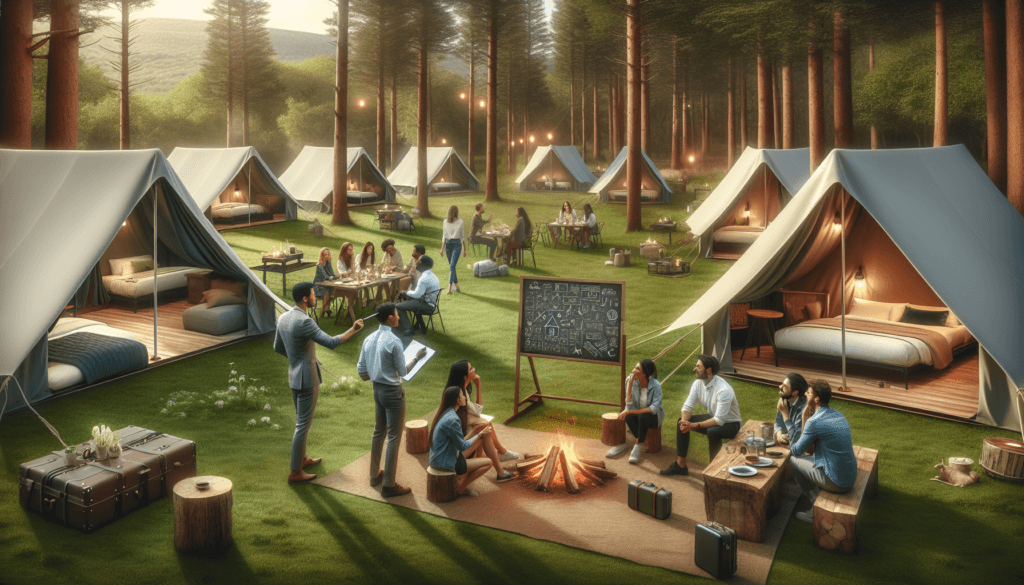Are you looking to plan a unique and memorable team building or corporate retreat experience? Look no further! In this article, we will guide you through the process of planning a glamping trip that combines the convenience of modern amenities with the charm of the great outdoors. Get ready to create an unforgettable bonding experience for your team, complete with luxurious accommodations, stunning natural surroundings, and exciting activities. So, grab your notepad and let’s begin the adventure of planning a glamping trip for team building and corporate retreats.

Choosing the Location
Consider the Purpose of the Trip
When planning a glamping trip for team building and corporate retreats, the first step is to consider the purpose of the trip. Think about what you want to achieve with this outing. Are you looking to foster teamwork, enhance communication, or simply provide a relaxing and enjoyable experience for your team? Identifying the purpose will help guide your decision-making process throughout the planning.
Identify the Desired Setting
The next step is to identify the desired setting for your glamping trip. Are you looking for a serene and remote location surrounded by nature? Or do you prefer a more convenient site with easy access to amenities and activities? Consider the preferences and needs of your team members when choosing the setting. The environment you select can greatly impact the success and enjoyment of the trip.
Research Potential Locations
Once you have an idea of the purpose and desired setting, it’s time to research potential locations. Look for glamping sites that align with your criteria. Consider factors such as proximity to your office, available activities, and the availability of accommodations that suit the needs of your team. Utilize online resources, read reviews, and reach out to the venues directly to gather all the necessary information to make an informed decision.
Evaluate Accessibility and Amenities
Accessibility and amenities are important factors to consider when choosing a glamping location. Determine how easily your team can reach the site, especially if traveling by car or public transportation. Additionally, assess the amenities available at the site. Does it offer comfortable lodging options? Are there communal spaces for meetings and team activities? Consider these factors to ensure that the chosen location can meet your team’s needs and facilitate a successful corporate retreat.
Determining the Duration
Consider the Availability of Participants
When determining the duration of your glamping trip, it is essential to consider the availability of your team members. Take into account their work schedules, personal commitments, and any upcoming projects or deadlines. Ensuring that the majority of your team can attend will maximize the effectiveness and impact of the team building activities.
Evaluate the Objectives and Activities
The objectives and planned activities for the glamping trip will also help determine the duration. If you have specific goals or workshops that require a significant amount of time, you may need a longer retreat. On the other hand, if you are focusing on relaxation and recreation, a shorter trip may be sufficient. Evaluate the objectives and activities on your itinerary to gauge how much time is needed to achieve them effectively.
Factor in Travel Time
Travel time is another crucial consideration when determining the duration of your glamping trip. If your chosen location is a considerable distance from your office, account for the time it will take to travel there and back. This will ensure that your team has ample time to rest and fully participate in the planned activities.
Ensure Sufficient Time for Team Building
Lastly, make sure to allocate sufficient time for team building activities. Team bonding and relationship-building exercises are essential for enhancing collaboration and improving team dynamics. By allowing enough time for these activities, you provide a space for your team to connect and grow together, ultimately benefiting your organization in the long run.
Defining Team Building Activities
Identify Goals and Objectives
To effectively define team building activities, start by identifying your goals and objectives. Determine what specific outcomes you hope to achieve through these activities. Are you aiming to improve communication, promote trust, or encourage problem-solving skills? Clearly defining your goals and objectives will help you select activities that align with these targets.
Tailor Activities to Suit the Team
Each team is unique, with different personalities, strengths, and weaknesses. Therefore, it is crucial to tailor team building activities to suit your specific team. Consider their preferences, interests, and comfort levels when selecting activities. This personalization will ensure that the activities resonate with your team and contribute to a successful glamping trip.
Include Icebreakers and Trust-Building Exercises
Icebreakers and trust-building exercises are essential components of any team building retreat. These activities help break down barriers, foster connections, and establish trust among team members. Incorporate icebreaking exercises into the beginning of your retreat to create a comfortable and welcoming atmosphere. Follow up with trust-building exercises to reinforce relationships and encourage open communication.
Consider Outdoor Adventure and Problem-Solving Activities
Glamping trips often take place in beautiful natural settings, providing an opportunity to include outdoor adventure and problem-solving activities. Team hikes, canoeing, or even a scavenger hunt can enhance teamwork, promote problem-solving skills, and create memorable experiences. Consider the location and the physical abilities of your team when selecting these activities to ensure everyone can participate and enjoy themselves.
Accommodation Options
Choose between Tents, Cabins, or Yurts
When planning a glamping trip, it’s important to consider the accommodation options available. Glamping typically offers a range of options, including tents, cabins, or yurts. Tents provide a more rustic and immersive experience, while cabins and yurts offer additional comfort and amenities. Choose the accommodation type that best suits your team’s preferences and requirements.
Consider Amenities and Facilities
Evaluate the amenities and facilities provided by the glamping site when selecting your accommodation. Are there shared bathrooms and showers, or does each accommodation have its own facilities? Are there communal spaces for gathering or conducting meetings? Consider the availability of Wi-Fi, electricity, and other essential amenities to ensure a comfortable and convenient stay for your team.
Evaluate Capacity and Comfort
Another crucial consideration is the capacity and comfort level of the accommodations. Assess the number of team members attending the retreat and choose accommodations that can comfortably accommodate everyone. Ensure that the beds, seating areas, and overall layout meet the needs of your team for a restful and enjoyable experience.
Ensure Adequate Privacy and Social Spaces
When selecting accommodation, striking the right balance between privacy and social spaces is essential. While it is crucial to provide opportunities for team bonding and interaction, team members also need personal space for relaxation and reflection. Choose accommodations that offer a combination of private areas and communal spaces to create an optimal environment for both personal and team-focused activities.

Meal Planning
Determine Dietary Restrictions
Consider the dietary restrictions and preferences of your team members when planning meals for your glamping trip. Request this information in advance to ensure that everyone’s needs are accommodated. Pay attention to allergies, intolerances, and cultural or religious dietary requirements to provide a varied and inclusive menu for all participants.
Consider Catering Options
Decide whether you will handle the meals internally or opt for catering services. Catering can be a convenient option, particularly if your glamping site offers this service. They can provide delicious and well-balanced meals, taking the pressure off your team to plan, cook, and clean up after each meal. Alternatively, if you have team members who enjoy cooking, you may decide to assign meal preparation to a designated group.
Plan for Breakfast, Lunch, and Dinner
When planning meals, ensure that you have options for breakfast, lunch, and dinner. Include a variety of dishes that cater to different tastes and dietary needs. Consider providing vegetarian, vegan, and gluten-free options to accommodate various preferences. Planning well-rounded meals will help keep your team energized and satisfied throughout the glamping trip.
Include Snacks and Beverages
In addition to main meals, don’t forget to include snacks and beverages in your meal planning. Glamping activities can be physically demanding, and team members may need refueling between meals. Offer a selection of healthy snacks such as fruits, nuts, and granola bars. Additionally, provide an assortment of beverages, including water, juices, and teas, to keep everyone hydrated throughout the day.
Logistics and Transportation
Arrange Group Transportation
Coordinate group transportation to and from the glamping site to ensure a smooth travel experience for your team. Determine whether you will be hiring a bus or van, or if team members will be driving individually. By arranging group transportation, you can facilitate team bonding during the journey, minimize the chances of getting lost, and reduce the environmental impact of multiple vehicles.
Consider Carpooling or Shuttle Services
If individual transportation is more suitable for your team, consider implementing a carpooling system. This encourages teamwork and reduces the number of vehicles on the road. Alternatively, inquire about shuttle services provided by the glamping site or nearby transportation companies. Shuttles can offer convenience and ease for team members who prefer not to drive themselves.
Plan for Parking
If team members will be driving to the glamping site, ensure that there is adequate parking available. Consider the number of vehicles and the site’s parking capacity to avoid any issues or inconvenience. Communicate parking instructions and guidelines to your team in advance to ensure a seamless arrival and departure experience.
Coordinate Check-in and Check-out Logistics
Smooth check-in and check-out processes are crucial for a well-organized glamping retreat. Prioritize effective communication to ensure that team members know when and where to check-in upon arrival. Provide them with clear instructions and contact details for any assistance they may require. Similarly, outline check-out procedures to ensure a hassle-free departure for all participants.

Budgeting and Cost Management
Estimate Total Expenses
To effectively budget for your glamping trip, start by estimating the total expenses. Consider all the elements involved, including accommodation, activities, transportation, meals, and any additional services or equipment rentals. This comprehensive estimate will provide a clear picture of the overall cost and help you allocate funds appropriately.
Consider Accommodation and Activity Costs
Evaluate the costs associated with accommodation and planned activities. Compare prices among different glamping sites to find the most suitable option within your budget. Take into account any additional fees such as deposits or cleaning charges. Prioritize quality and value for money when making final decisions.
Factor in Transportation and Meals
Transportation and meals are significant cost factors to consider. Calculate the estimated expenses for group transportation and factor in the cost of meals based on the number of participants and your planned menu. Keep in mind any additional costs for catering or rental equipment. By accurately estimating these costs, you can make informed financial decisions and ensure that your glamping trip remains within budget.
Allocate a Contingency Fund
No matter how well you plan, unexpected expenses can arise during a glamping trip. It is prudent to allocate a contingency fund to account for unforeseen costs. This buffer will provide peace of mind and flexibility to handle any emergency situations or last-minute adjustments without compromising the overall experience for your team.
Communication and Information
Prepare Event Invitations and Details
Effective communication is key when organizing a glamping trip. Start by preparing event invitations and details to ensure that your team members are well-informed. Include essential information such as the purpose, dates, times, and what participants need to bring. Provide a clear outline of the itinerary and any specific instructions or guidelines.
Share Itinerary and Schedule
Share the itinerary and schedule of the glamping trip with your team in advance. This will help them mentally prepare, plan their personal commitments, and pack accordingly. Include details of team building activities, meals, and any free time for relaxation or exploration. Sharing the schedule helps create a sense of anticipation and allows individuals to plan their participation effectively.
Provide Packing Lists and Guidelines
Help your team prepare for the glamping trip by providing comprehensive packing lists and guidelines. Consider the specific activities planned and suggest appropriate clothing and footwear. Encourage participants to bring personal items such as toiletries, sunscreen, insect repellents, and any specialized equipment they may need. By providing packing guidance, you ensure that team members are well-prepared and comfortable during their stay.
Establish Emergency Communication Channels
Establishing clear and accessible emergency communication channels is crucial for the safety and well-being of your team. Communicate emergency contact numbers, the location of first aid kits, and any site-specific guidelines for emergencies. Create a central communication point where team members can contact designated individuals in case of any issues or concerns. Prioritize their safety and provide them with the necessary information and resources to handle any emergencies that may arise.

Safety and Risk Management
Conduct Risk Assessments
Before embarking on a glamping trip, conduct thorough risk assessments to identify potential hazards or risks. Evaluate the activities planned, the glamping site’s safety measures, and any external factors that may pose a risk. Mitigate these risks by implementing appropriate safety protocols and guidelines. Regularly review and update these assessments to ensure the ongoing safety of your team.
Ensure Emergency Preparedness
Being well-prepared for emergencies is essential during any team building or corporate retreat. Familiarize yourself with the location’s emergency procedures and communicate them to your team. Ensure that first aid kits are available and stocked appropriately. Have a designated individual or team responsible for handling emergencies and designating a meeting point for safety purposes.
Inform Participants of Safety Guidelines
Communication about safety guidelines is vital to maintain the well-being of your team members during the glamping trip. Share important safety information with your team, including guidelines for outdoor activities, fire safety, and proper use of equipment. Encourage individuals to practice caution and responsibility during their stay. By ensuring that everyone is aware of and follows safety guidelines, you minimize the risk of accidents or injuries.
Designate First Aid and Medical Support
Designate individuals responsible for providing first aid and medical support during the glamping trip. Ensure that these team members are adequately trained and equipped to handle any medical emergencies that may occur. Communicate their roles and contact information to the rest of the group, making it easy for participants to seek assistance when needed. Having designated medical support helps create a safe and secure environment for your team.
Evaluation and Feedback
Collect Participant Feedback
After the glamping trip, collect feedback from participants to assess their experience and the effectiveness of the team building activities. Prepare a survey or set up a feedback session to gather their thoughts, opinions, and suggestions. This feedback is invaluable in identifying what worked well and what areas can be improved upon for future retreats.
Review the Achievement of Objectives
Evaluate whether the objectives set for the glamping trip were accomplished. Review the progress made towards team building, communication improvement, or other targeted outcomes. Compare the actual outcomes with your initial goals to assess the success of the retreat. This evaluation will help you gauge the impact of the glamping trip on your team’s dynamics and overall performance.
Assess the Success of Team Building Activities
Assess the success of the team building activities by soliciting feedback from participants and observing their engagement and interaction during the retreat. Measure the level of participation, enthusiasm, and the growth exhibited by team members. Evaluate whether the activities effectively fostered teamwork, trust-building, and other desired outcomes. This assessment will help refine your future team building efforts and ensure continuous improvement.
Identify Areas for Improvement
Based on the feedback received and the evaluation of the glamping trip, identify areas that can be improved for future retreats. Review what worked well and what could be enhanced to create an even more impactful experience for your team. Consider suggestions made by participants and implement necessary changes to enhance the effectiveness and enjoyment of future glamping trips.
Planning a glamping trip for team building and corporate retreats can be an exciting and rewarding endeavor. By carefully considering factors such as the purpose, desired setting, activities, accommodation, meal planning, logistics, budgeting, communication, safety, and evaluation, you can create a memorable experience that fosters team cohesion, personal growth, and organizational success. Embrace the opportunity to bond with your team in a unique and inspiring outdoor setting, and watch the positive impact ripple through your organization. Happy glamping!



